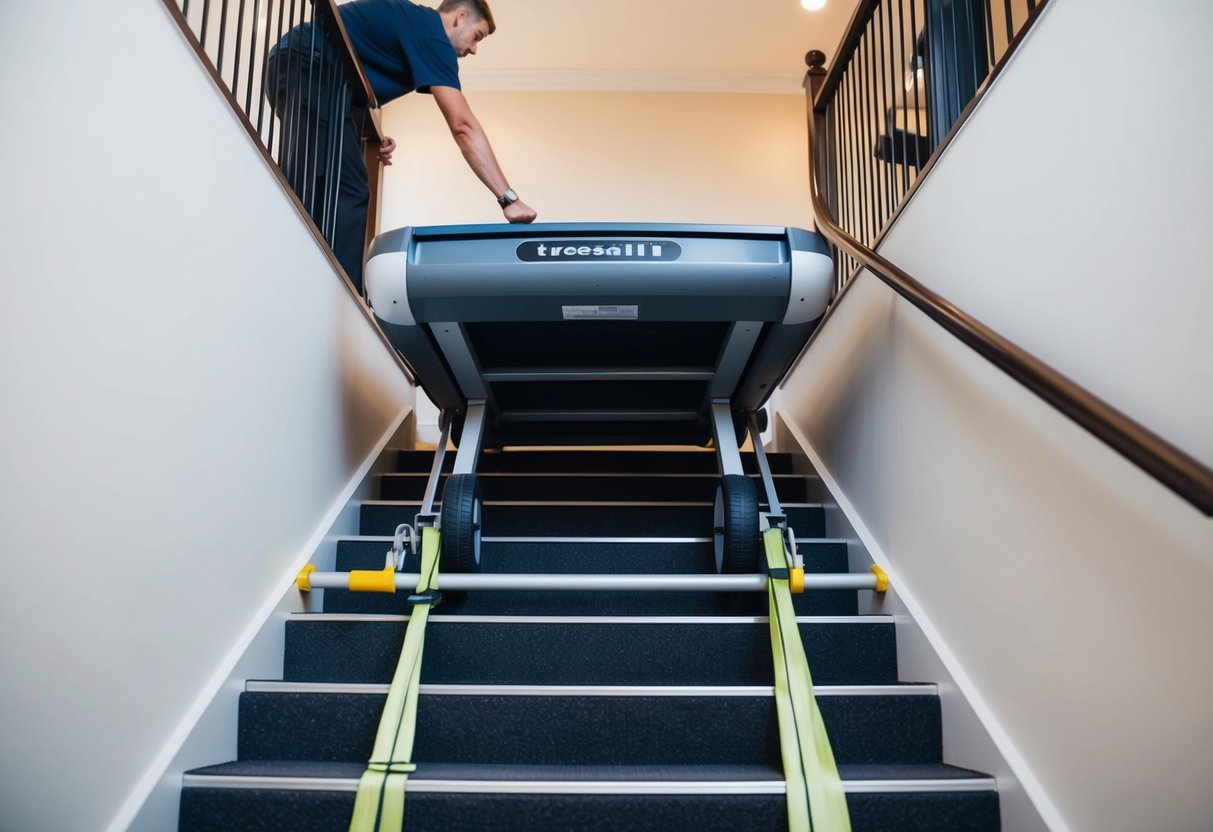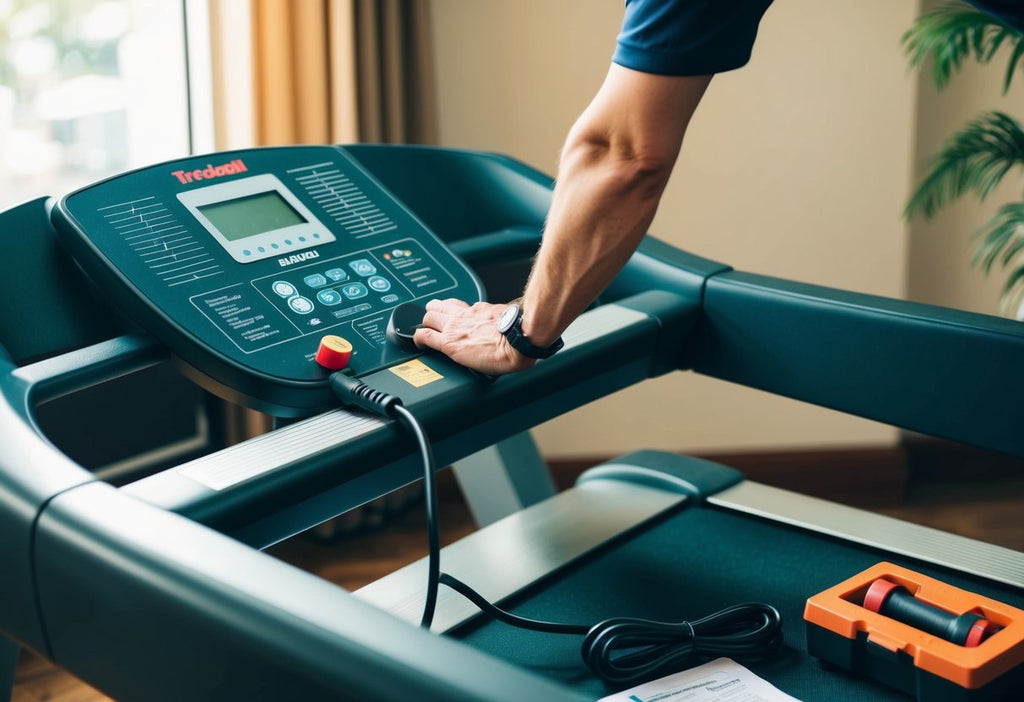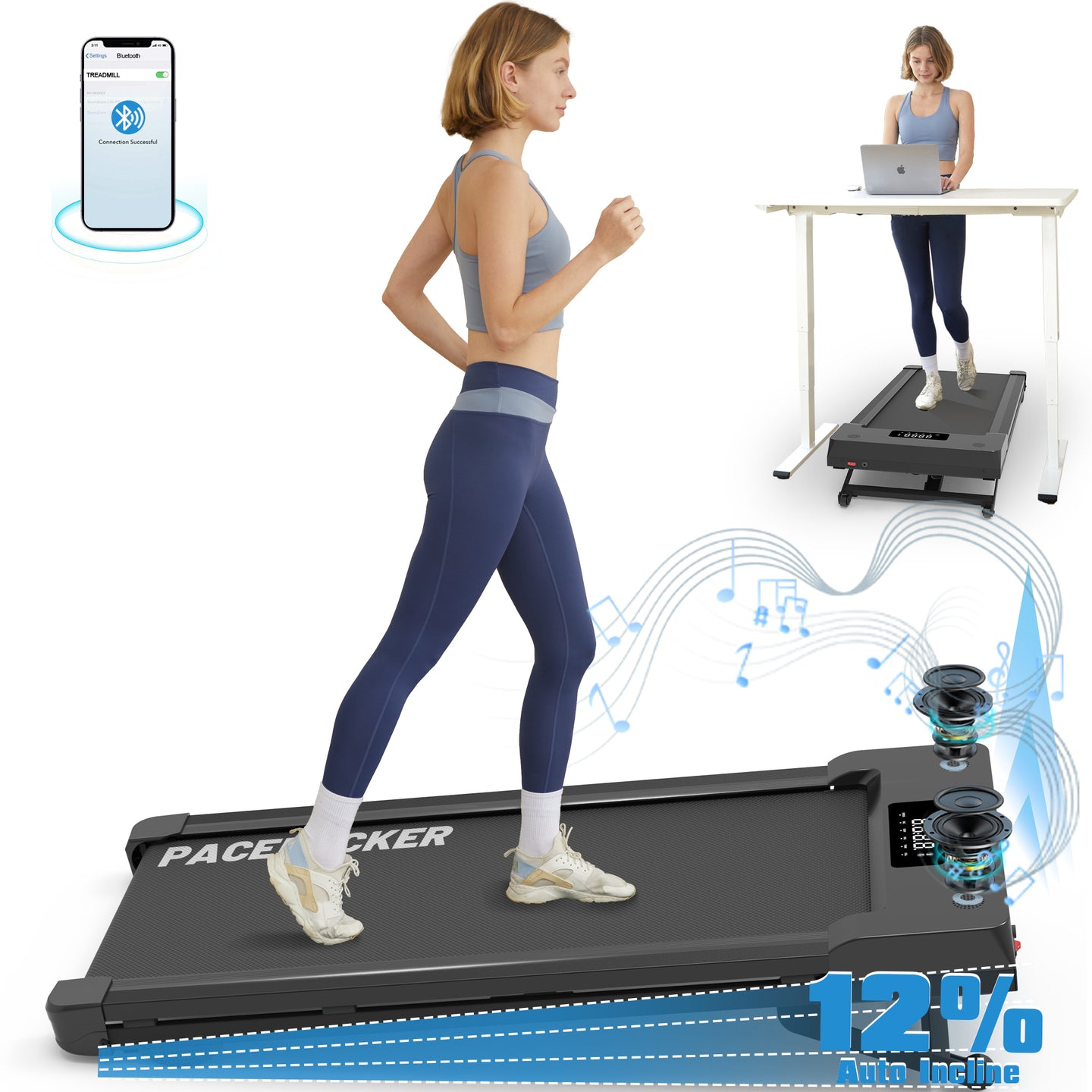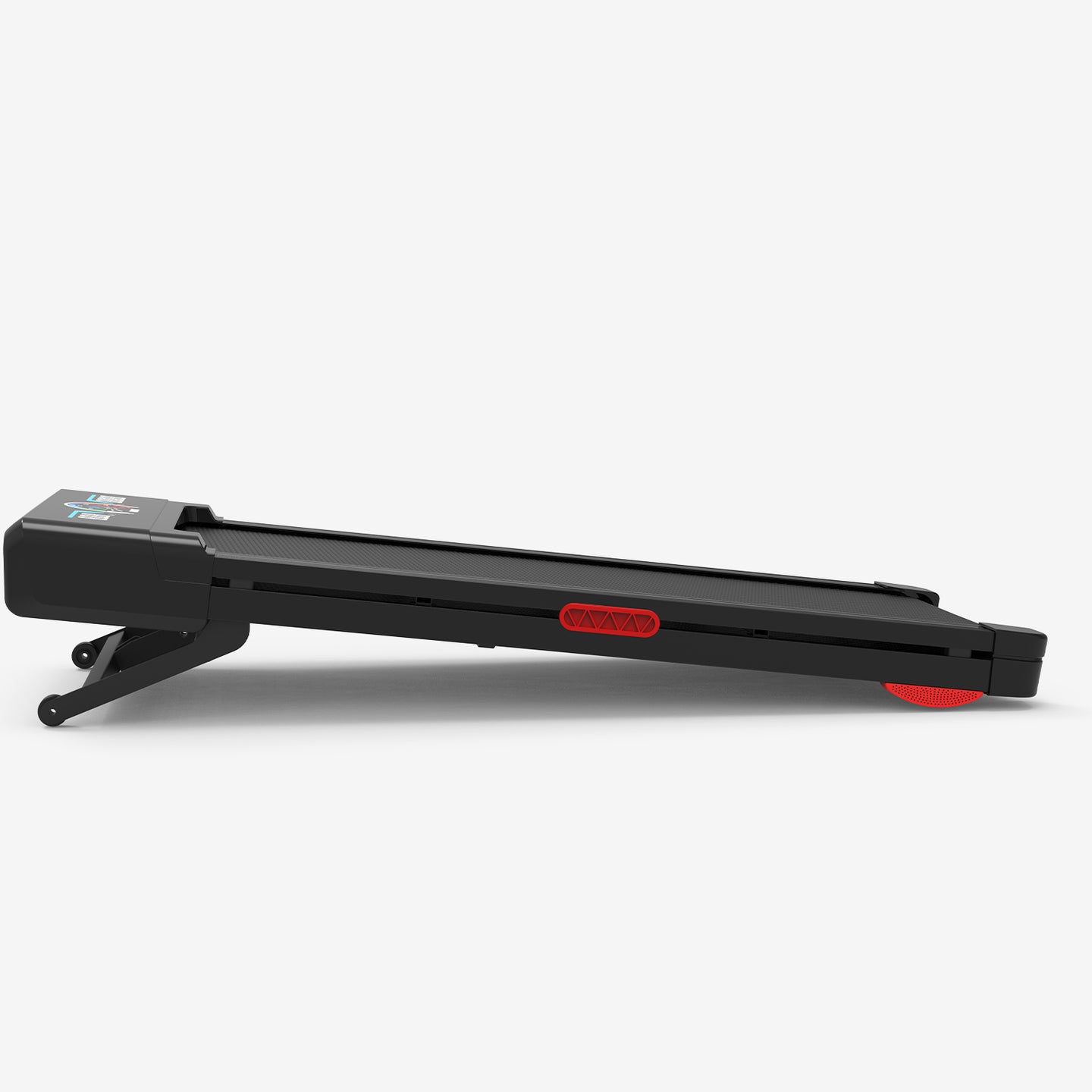How to Move a Treadmill Down Stairs

How to Move a Treadmill Down Stairs
Don’t forget to check out our Pacerocker, Trailviber, and Trailviber Auto Incline walking pad treadmills.
Moving a treadmill downstairs can feel like a monumental task, but with the right strategy, it becomes manageable.
Our key to success is thorough preparation and attention to safety.
Taking care to protect both yourself and your treadmill should be a top priority.
Fortunately, with some planning and a bit of teamwork, this daunting task becomes much easier.
Before we start, it’s essential to gather the necessary tools and plan the logistics carefully.
We'll go through the steps together, ensuring a smooth transition to its new location.
Consider the size of the treadmill and the dimensions of the stairway to avoid any surprises.
The move itself will require technique and patience. We'll guide you through the process of navigating corners and handling the weight to ensure a safe journey downstairs.
By being organized and prepared, we can prevent mishaps and keep the treadmill in perfect condition.
Key Takeaways
-
Prioritize safety and proper planning before moving.
-
Use teamwork and proper techniques for effective moving.
-
Measure thoroughly to avoid surprises during navigation.
Safety First
To ensure a safe and smooth process when moving a treadmill downstairs, it's vital for us to evaluate the staircase, gather proper equipment, and involve trusted helpers.
Assessing the Staircase
Before anything else, we should carefully inspect the staircase. Determine the width and length to confirm the treadmill can pass through without difficulty.
Check for obstacles like furniture or loose carpeting that could interfere with the move.
Consider the type of stairs: are they straight, curved, or spiral? Note the measures to navigate each type effectively.
It’s paramount to assess the lighting — dim lighting can pose a risk. Let’s ensure there's enough light or set up temporary lights for better visibility.
A clear, well-lit path reduces the risk of accidents.
Proper Equipment
We can’t ignore the importance of using the right equipment.
Essential items include a furniture dolly, straps, and non-slip gloves. A dolly can help bear the weight, making movement smoother.
Straps ensure the treadmill stays secure on the dolly during transit.
Gloves with a good grip will protect our hands and provide better control.
If possible, a stair-climbing dolly is invaluable, as it’s designed specifically for moving heavy items up and down stairs.
It’s crucial to wear sturdy, comfortable shoes with good traction to prevent slips.
Recruiting Helpers
It’s always safer and more efficient when we enlist at least one or two extra pairs of hands.
Choose individuals who are physically able and have some experience in moving heavy items.
Clearly communicate and plan the maneuver before starting.
Assign roles based on physical strength and position. One person should guide from below, offering support and direction, while the others carefully lower the treadmill.
Having strong, reliable helpers ensures better control during the process. This teamwork significantly reduces the risk of injury or damage.
Preparation Steps
Before moving a treadmill down the stairs, it's essential to ensure everything is secure, create a clear path, and get our bodies ready for the task.
A thorough preparation will make the process smoother and reduce the risk of injury or damage.
Securing Loose Parts
First, we need to secure any loose parts on the treadmill. Let's start by folding the treadmill, if it has that feature. Use straps or bungee cords to hold it securely in its folded position.
Check for any detachable components like console covers or side rails. Remove and store them safely.
For added security, tightly wrap power cords and any other dangling parts using zip ties or tape. Taking these precautions will prevent unexpected movements that could complicate our task.
Clearing the Path
Clearing a wide and accessible path is crucial when moving heavy equipment like a treadmill.
Start by identifying the staircase we’ll be using, ensuring it's strong enough to support the treadmill's weight.
Remove obstacles such as furniture, rugs, or decorations from the path leading to and down the stairs.
If possible, recruit a couple of helpers to guide us and signal any potential issues during the move.
Having a clear and unobstructed path will make the transition down the stairs much safer.
Warming Up
Warming up prepares our bodies for the physical effort involved in moving a treadmill.
We’ll begin with light stretching exercises focusing on our legs, arms, and back muscles.
A few minutes of brisk walking or jogging in place will increase our heart rate and get us ready for the task.
Another crucial step is to wear appropriate footwear with good grip to prevent slips.
By warming up, we're not only preparing our bodies but also minimizing the risk of strains or injuries.
Moving Techniques
Moving a treadmill downstairs requires careful planning and execution. By knowing the right techniques, we can safely and effectively transport this heavy piece of equipment without causing injury or damage.
Lift and Slide Method
The lift-and-slide method involves two or more people.
We begin by gathering a team who can handle the treadmill's weight. Position the treadmill near the top of the stairs.
One person stands at the top to help guide and lift, while another stands lower on the stairs to support the weight.
We should lift the front end slightly off the ground while keeping it stable. Ensure that everyone has a firm grip, and slowly slide the treadmill one step at a time.
This method requires coordination and clear communication among team members to ensure safety and stability throughout the process. Using proper lifting techniques by bending at the knees and maintaining a straight back will help prevent injuries.
Using a Furniture Dolly
For this method, we’ll need a sturdy furniture dolly.
Start by securing the treadmill onto the dolly with strong straps or bungee cords to prevent it from shifting. Make sure they're tight, and the treadmill is balanced.
Carefully roll the dolly to the edge of the stairs.
Once at the stairs, it’s crucial to maintain control. One person stands below the dolly to manage the descent, while another supports from above, preventing excessive speed.
We should take one step at a time, allowing each participant to brace and adjust their hold as needed.
Roll the dolly slowly, ensuring that all wheels are gripping the steps to avoid slips or falls. This technique minimizes the physical strain of carrying the treadmill manually and provides a safer descent.
Navigating the Stairs
Moving a treadmill downstairs can be tricky, especially when dealing with tight corners and narrow spaces. We need to ensure safety and efficiency by following specific steps and using proper techniques.
Step-by-Step Descent
First, we should measure the dimensions of the treadmill and the staircase. This helps us anticipate potential problem areas.
It's crucial to have a sturdy grip on both ends of the treadmill. Using a moving strap can provide additional support, reducing strain on our arms.
Before we begin, clear any obstacles from the stairs. Proper footwear ensures stability, and wearing gloves protects our hands during the move.
We need to communicate clearly with anyone assisting us, coordinating each step to maintain balance and control.
Taking slow and steady steps is essential to avoid accidents. Pausing occasionally helps adjust our grip and check for any unexpected issues that may arise.
Handling Turns and Landings
Tight turns or landings present potential challenges in moving the treadmill.
Before reaching a turn, we should tilt the treadmill slightly, allowing for a smoother pivot.
Collaborative effort is key. Having one person guide the front while another manages the back can prevent mishaps.
If a landing is involved, we should pause and assess the space available. This extra step ensures we maintain control.
Adjusting our positions and planning the next phase reduces risks.
On narrow turns, it's beneficial to tilt the treadmill onto its side. This maneuver minimizes the space taken up by the treadmill, making it easier to navigate through tighter areas.
Using these strategies helps us maintain safety and efficiency.
Post-Move Considerations
After successfully moving a treadmill down the stairs, it's crucial for us to focus on setting it up again and ensuring everything functions smoothly. The reassembly should be meticulous, and a thorough equipment inspection is essential to keep the treadmill operating well for our fitness journey.
Reassembling the Treadmill
Reconstructing the treadmill may seem daunting, but with patience, it's manageable. Start by referring to the user manual for assembly instructions, making sure we have all the necessary tools at hand.
Aligning the frame parts correctly is vital. Pay special attention to the console and handrails—ensuring they are securely fixed can prevent accidents during workouts.
We should double-check that all screws and bolts are tightly fastened. Loose parts can compromise stability.
Plugging it in and verifying the electronic systems, such as the display and speed settings, will ensure everything's working as intended.
Noticing any issues early allows us to address them promptly.
Equipment Check
Once the treadmill is assembled, it's crucial for us to conduct a thorough inspection and test run.
Examine the power cord and ensure there are no frayed wires or damage.
Check the running belt for proper alignment and tension. It should move smoothly without any jerking or sticking.
Running a few speed level checks helps in identifying unusual noises or vibrations, which may indicate misalignment or mechanical issues.
We should also ensure that the safety key is in place and functional.
Taking these steps aids in maintaining our treadmill's longevity and in securing a safe workout environment.
Frequently Asked Questions
When we're moving a treadmill downstairs, our primary concerns include safety, the potential need for professional help, and how to maneuver the treadmill without causing damage. Getting through tight spaces adds an extra layer of complexity.
What is the safest way to navigate moving a heavy treadmill down a flight of stairs?
Safety comes first. We recommend securing a firm grip while ensuring everyone involved communicates clearly.
It’s wise to use a sturdy dolly and stabilizing straps. Steady, coordinated movement is crucial.
Can I transport a treadmill to another room without disassembling it?
It's possible, depending on doorframes and available space. Before we decide, checking the treadmill's dimensions against doorway widths helps.
We should also plan our path and clear obstacles.
What tools or equipment are recommended for moving a large treadmill downstairs?
Using a furniture dolly and moving straps can help. Protective blankets prevent scratches.
We also find that having a set of basic tools nearby is useful if adjustments are necessary.
Is it necessary to hire professional movers for relocating a treadmill to a lower floor?
While it's not always necessary, professionals have the experience and equipment to handle heavy lifting safely.
If we feel uneasy about the process, hiring movers can minimize risk.
How do you protect both the treadmill and the staircase during the move?
We use pads or moving blankets to protect both the equipment and the stairs.
Securing the treadmill with straps minimizes movement, reducing the chance of damage.
Ensuring clear communication keeps the move controlled.
What are effective strategies for maneuvering a treadmill through narrow doorways or tight corners while moving it?
Tilting the treadmill slightly may help us navigate corners more easily. Breaking down components, if possible, can also aid movement.
Taking accurate measurements beforehand ensures the planned route is feasible.
Move your treadmill downstairs safely with proper planning, teamwork, and equipment. Follow these expert steps to avoid damage and ensure a smooth process!







